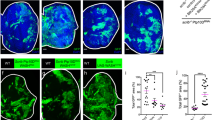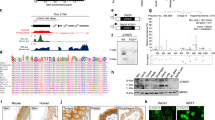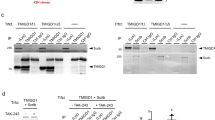Abstract
Scribble (SCRIB) is a tumor-suppressor protein, playing critical roles in establishing and maintaining epithelial cell polarity. SCRIB is frequently amplified in human cancers but does not localize properly to cell-cell junctions, suggesting that mislocalization of SCRIB disrupts its tumor-suppressive activities. Using chemical reporters, here we showed that SCRIB localization was regulated by S-palmitoylation at conserved cysteine residues. Palmitoylation-deficient mutants of SCRIB were mislocalized, leading to disruption of cell polarity and loss of their tumor-suppressive activities to oncogenic YAP, MAPK and PI3K/AKT pathways. We further found that ZDHHC7 was the major palmitoyl acyltransferase regulating SCRIB. Knockout of ZDHHC7 led to SCRIB mislocalization and YAP activation, and disruption of SCRIB's suppressive activities in HRasV12-induced cell invasion. In summary, we demonstrated that ZDHHC7-mediated SCRIB palmitoylation is critical for SCRIB membrane targeting, cell polarity and tumor suppression, providing new mechanistic insights of how dynamic protein palmitoylation regulates cell polarity and tumorigenesis.
This is a preview of subscription content, access via your institution
Access options
Subscribe to this journal
Receive 12 print issues and online access
$259.00 per year
only $21.58 per issue
Buy this article
- Purchase on Springer Link
- Instant access to full article PDF
Prices may be subject to local taxes which are calculated during checkout






Similar content being viewed by others
References
Martin-Belmonte, F. & Perez-Moreno, M. Epithelial cell polarity, stem cells and cancer. Nat. Rev. Cancer 12, 23–38 (2012).
Bilder, D. & Perrimon, N. Localization of apical epithelial determinants by the basolateral PDZ protein Scribble. Nature 403, 676–680 (2000).
Bilder, D., Li, M. & Perrimon, N. Cooperative regulation of cell polarity and growth by Drosophila tumor suppressors. Science 289, 113–116 (2000).
Elsum, I.A., Martin, C. & Humbert, P.O. Scribble regulates an EMT polarity pathway through modulation of MAPK-ERK signaling to mediate junction formation. J. Cell Sci. 126, 3990–3999 (2013).
Zhan, L. et al. Deregulation of scribble promotes mammary tumorigenesis and reveals a role for cell polarity in carcinoma. Cell 135, 865–878 (2008).
Pearson, H.B. et al. SCRIB expression is deregulated in human prostate cancer, and its deficiency in mice promotes prostate neoplasia. J. Clin. Invest. 121, 4257–4267 (2011).
Feigin, M.E. et al. Mislocalization of the cell polarity protein scribble promotes mammary tumorigenesis and is associated with basal breast cancer. Cancer Res. 74, 3180–3194 (2014).
Dow, L.E. et al. Loss of human Scribble cooperates with H-Ras to promote cell invasion through deregulation of MAPK signalling. Oncogene 27, 5988–6001 (2008).
Godde, N.J. et al. Scribble modulates the MAPK/Fra1 pathway to disrupt luminal and ductal integrity and suppress tumour formation in the mammary gland. PLoS Genet. 10, e1004323 (2014).
Cordenonsi, M. et al. The Hippo transducer TAZ confers cancer stem cell-related traits on breast cancer cells. Cell 147, 759–772 (2011).
Mohseni, M. et al. A genetic screen identifies an LKB1-MARK signalling axis controlling the Hippo-YAP pathway. Nat. Cell Biol. 16, 108–117 (2014).
Santoni, M.J., Pontarotti, P., Birnbaum, D. & Borg, J.P. The LAP family: a phylogenetic point of view. Trends Genet. 18, 494–497 (2002).
Zeitler, J., Hsu, C.P., Dionne, H. & Bilder, D. Domains controlling cell polarity and proliferation in the Drosophila tumor suppressor Scribble. J. Cell Biol. 167, 1137–1146 (2004).
Navarro, C. et al. Junctional recruitment of mammalian Scribble relies on E-cadherin engagement. Oncogene 24, 4330–4339 (2005).
Audebert, S. et al. Mammalian Scribble forms a tight complex with the betaPIX exchange factor. Curr. Biol. 14, 987–995 (2004).
Linder, M.E. & Deschenes, R.J. Palmitoylation: policing protein stability and traffic. Nat. Rev. Mol. Cell Biol. 8, 74–84 (2007).
Hannoush, R.N. & Sun, J. The chemical toolbox for monitoring protein fatty acylation and prenylation. Nat. Chem. Biol. 6, 498–506 (2010).
Hang, H.C. & Linder, M.E. Exploring protein lipidation with chemical biology. Chem. Rev. 111, 6341–6358 (2011).
Zheng, B. et al. 2-Bromopalmitate analogues as activity-based probes to explore palmitoyl acyltransferases. J. Am. Chem. Soc. 135, 7082–7085 (2013).
Martin, B.R., Wang, C., Adibekian, A., Tully, S.E. & Cravatt, B.F. Global profiling of dynamic protein palmitoylation. Nat. Methods 9, 84–89 (2012).
Kang, R. et al. Neural palmitoyl-proteomics reveals dynamic synaptic palmitoylation. Nature 456, 904–909 (2008).
Wei, X., Song, H. & Semenkovich, C.F. Insulin-regulated protein palmitoylation impacts endothelial cell function. Arterioscler. Thromb. Vasc. Biol. 34, 346–354 (2014).
Martin, B.R. & Cravatt, B.F. Large-scale profiling of protein palmitoylation in mammalian cells. Nat. Methods 6, 135–138 (2009).
Li, Y., Martin, B.R., Cravatt, B.F. & Hofmann, S.L. DHHC5 protein palmitoylates flotillin-2 and is rapidly degraded on induction of neuronal differentiation in cultured cells. J. Biol. Chem. 287, 523–530 (2012).
Yang, W., Di Vizio, D., Kirchner, M., Steen, H. & Freeman, M.R. Proteome scale characterization of human S-acylated proteins in lipid raft-enriched and non-raft membranes. Mol. Cell. Proteomics 9, 54–70 (2010).
Zhang, M.M., Tsou, L.K., Charron, G., Raghavan, A.S. & Hang, H.C. Tandem fluorescence imaging of dynamic S-acylation and protein turnover. Proc. Natl. Acad. Sci. USA 107, 8627–8632 (2010).
O'Brien, L.E., Zegers, M.M. & Mostov, K.E. Building epithelial architecture: insights from three-dimensional culture models. Nat. Rev. Mol. Cell Biol. 3, 531–537 (2002).
Elsum, I.A. & Humbert, P.O. Localization, not important in all tumor-suppressing properties: a lesson learnt from scribble. Cells Tissues Organs 198, 1–11 (2013).
Johnson, R. & Halder, G. The two faces of Hippo: targeting the Hippo pathway for regenerative medicine and cancer treatment. Nat. Rev. Drug Discov. 13, 63–79 (2014).
Moroishi, T., Hansen, C.G. & Guan, K.L. The emerging roles of YAP and TAZ in cancer. Nat. Rev. Cancer 15, 73–79 (2015).
Yang, C.C. et al. Differential regulation of the Hippo pathway by adherens junctions and apical-basal cell polarity modules. Proc. Natl. Acad. Sci. USA 112, 1785–1790 (2015).
Li, X., Yang, H., Liu, J., Schmidt, M.D. & Gao, T. Scribble-mediated membrane targeting of PHLPP1 is required for its negative regulation of Akt. EMBO Rep. 12, 818–824 (2011).
Legouis, R. et al. Basolateral targeting by leucine-rich repeat domains in epithelial cells. EMBO Rep. 4, 1096–1102 (2003).
Pedram, A., Razandi, M., Deschenes, R.J. & Levin, E.R. DHHC-7 and -21 are palmitoylacyltransferases for sex steroid receptors. Mol. Biol. Cell 23, 188–199 (2012).
Vaira, V. et al. Aberrant overexpression of the cell polarity module scribble in human cancer. Am. J. Pathol. 178, 2478–2483 (2011).
Hungermann, D. et al. Influence of whole arm loss of chromosome 16q on gene expression patterns in oestrogen receptor-positive, invasive breast cancer. J. Pathol. 224, 517–528 (2011).
Harvey, K.F., Zhang, X. & Thomas, D.M. The Hippo pathway and human cancer. Nat. Rev. Cancer 13, 246–257 (2013).
Chan, P. et al. Autopalmitoylation of TEAD proteins regulates transcriptional output of the Hippo pathway. Nat. Chem. Biol. 12, 282–289 (2016).
Rossin, A. et al. Fas palmitoylation by the palmitoyl acyltransferase DHHC7 regulates Fas stability. Cell Death Differ. 22, 643–653 (2015).
Fukata, Y. & Fukata, M. Protein palmitoylation in neuronal development and synaptic plasticity. Nat. Rev. Neurosci. 11, 161–175 (2010).
Rocks, O. et al. The palmitoylation machinery is a spatially organizing system for peripheral membrane proteins. Cell 141, 458–471 (2010).
Wan, J., Roth, A.F., Bailey, A.O. & Davis, N.G. Palmitoylated proteins: purification and identification. Nat. Protoc. 2, 1573–1584 (2007).
Duncan, J.A. & Gilman, A.G. A cytoplasmic acyl-protein thioesterase that removes palmitate from G protein alpha subunits and p21(RAS). J. Biol. Chem. 273, 15830–15837 (1998).
Rocks, O. et al. An acylation cycle regulates localization and activity of palmitoylated Ras isoforms. Science 307, 1746–1752 (2005).
Dekker, F.J. et al. Small-molecule inhibition of APT1 affects Ras localization and signaling. Nat. Chem. Biol. 6, 449–456 (2010).
Debnath, J., Muthuswamy, S.K. & Brugge, J.S. Morphogenesis and oncogenesis of MCF-10A mammary epithelial acini grown in three-dimensional basement membrane cultures. Methods 30, 256–268 (2003).
Acknowledgements
This work was supported by Stewart Rahr–MRA (Melanoma Research Alliance) Young Investigator Award, Research Scholar Award from American Cancer Society (124929-RSG-13-291-01-TBE), and grants from National Institutes of Health (R01CA181537 and R01DK107651-01) to X.W. We appreciate W.-L. Yan for his generous philanthropic donation to Massachusetts General Hospital to support Y.S.B.'s training and research. We thank M. Fukata (National Institute for Physiological Sciences, Japan) for the expression vectors of DHHC proteins, the Confocal Imaging Core at Cutaneous Biology Research Center of Massachusetts General Hospital, and the Shared Instrumentation Grant that covered the purchase of the microscope (1S10RR027673-01), and the Taplin Mass Spec Core at Harvard Medical School for proteomic studies.
Author information
Authors and Affiliations
Contributions
X.W. conceived the concept and supervised the project. B.C. and X.W. designed the experiments. B.Z. and G.K.J. synthesized the probes, and B.Z. identified Scribble from proteomic studies. B.C. performed biochemistry and cell biology experiments with the help from M.D., G.K.J., J.F., and Y.S.B. B.C. and X.W. wrote the paper. All authors discussed the results and commented on the manuscript.
Corresponding author
Ethics declarations
Competing interests
The authors declare no competing financial interests.
Supplementary information
Supplementary Text and Figures
Supplementary Results and Supplementary Figures 1–49. (PDF 32493 kb)
Rights and permissions
About this article
Cite this article
Chen, B., Zheng, B., DeRan, M. et al. ZDHHC7-mediated S-palmitoylation of Scribble regulates cell polarity. Nat Chem Biol 12, 686–693 (2016). https://doi.org/10.1038/nchembio.2119
Received:
Accepted:
Published:
Issue Date:
DOI: https://doi.org/10.1038/nchembio.2119
This article is cited by
-
Estrogen Regulates Scribble Localization in Endometrial Epithelial Cells Through Acyl Protein Thioesterase (APT)-Mediated S-Palmitoylation in Adenomyosis
Reproductive Sciences (2024)
-
Palmitoylation-driven PHF2 ubiquitination remodels lipid metabolism through the SREBP1c axis in hepatocellular carcinoma
Nature Communications (2023)
-
The Elk-3 target Abhd10 ameliorates hepatotoxic injury and fibrosis in alcoholic liver disease
Communications Biology (2023)
-
Palmitoyl acyltransferase ZDHHC7 inhibits androgen receptor and suppresses prostate cancer
Oncogene (2023)
-
Membrane recruitment of the polarity protein Scribble by the cell adhesion receptor TMIGD1
Communications Biology (2023)



